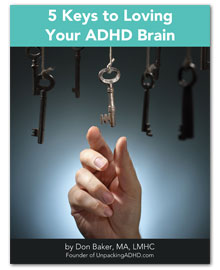What We Can Learn from “Phelps Face”
The image above of Michael Phelps at the recent Olympics in Rio stuck with me. That’s him on the left (photo from USA Today). I wondered what he was listening to and why the frown? Were his headphones a strategy to reduce distraction?
After a little digging, I found the answer. Phelps explained on the Today show in August: “I just had music going on in my head. I had thoughts going on in my head, spitting water a little bit all over the place, so I was in my own zone.”
And if you wondered what the most decorated Olympian of all times was listening to in the photo? He explained, this past Sunday at the VMA’s, why he looked so intense in the photo: “I was in the zone with Future’s track ‘Stick Talk’ blaring in my headphones.”
Knowing that Michael Phelps lives with ADHD, I made the assumption when I saw the broadcast of the event that he was using the headphones as one piece of an intricate arsenal of strategies to reduce distraction and stay in control. Not only was he wearing his headphones in the warm up room with eyes closed, intense look on his face — he wore them as he walked up to the podium for his event! Right up until the time he was ready to start. Amazing!
The ADHD Paradox
Remember that ADHD is a paradox — extreme strengths coupled with extreme challenges. When you watch Michael Phelps swim, he embodies precision and amazing laser focus. And, the flip side this is the same guy who was diagnosed ADHD in elementary school, whose school performance suffered because of how difficult it was for him to focus. The same guy who has just become the most decorated Olympian. The guy sitting with the frown and headphones. And the same guy who has struggled with substance abuse. In September 2014, after leaving a casino, was pulled over and arrested for DUI. He subsequently spent 45 days in treatment.
I’ve read that Michael’s mom introduced him to swimming to help him manage his abundant undermanned attention. He has said that swimming and competition helped him maintain his focus, and the routine of swim practice helped him managed his daily life.
In another piece, he explains his training tactic. It’s fairly straightforward — he just swims consistently with the same pace, from the start till the end. His strokes remain uniform like robot, from the start to end. Nothing spontaneous. When other swimmers are fighting against fatigue, Phelps still swims calmly as if he is swimming downhill with his smooth strokes. It’s not that he’s not tired, but his ability to relax and focus allow him to block out the pain and fatigue. He has strong mind power and is highly competitive, and that is what drives him.
Coach Bob Bowman started training Michael Phelps when Phelps was only 11 years old. He pushed Phelps to swim at least 50 miles each week. Phelps trained almost 5 hours a day and 7 days a week without any rest day.
Here’s a link to Coach Bowman’s book: The Golden Rules: 10 Steps to World-Class Excellence in Your Life and Work. And to a great interview with Bowman.
Five ADHD Champion Takeaways
Michael Phelps is a unique human being with or without ADHD. But as a therapist working with those living with traits of ADHD, I recognize that “thing” Phelps embodies. When someone living with ADHD traits begins to use their strengths and learn to mitigate their challenges, they become capable of amazing things.
Here are some key principles and takeaways:
- Practice, practice, practice. Even when you’re inclined to give up, keep going.
- Structure. Use all kinds of support —coach, therapist, friend, mentor, body double — to provide accountability and to be there when you feel like giving up. Michael’s mom is quoted saying, “We had to keep him structured. As long as he was on a schedule, he was great. We also used a task chart, where you had to get all these things accomplished before you were able to do other things. I always made sure that when he got home from school that he got something to eat and that he went outside for a certain amount of time to be able to relieve some of that energy before he did his homework and before he went to swim practice. Our family became a team, and the girls paid attention to Michael’s eating habits. We also observed time restrictions on some activities to teach him time management, and he began making choices so that he could use his time more wisely, just as he would at the pool.”
- Have a mechanism in place to get “back on” your practice when you fall off. Every human being has imperfect follow-through. It is not unique to ADHD. So don’t fret about not sustaining your effort. Instead, be clear about how you are going to get back to your “practice.” See David Allen’s book Making It All Work: Winning at the Game of Work and the Business of Life for some wisdom and specific strategies for this.
- Pace yourself. Just like Phelps who swims consistently with same pace, from the start till the end. His strokes remain uniform like robot, from the start to end. Nothing spontaneous. When you want to get something done, guard your mind’s open window, reduce distraction, and simply maintain your pace.
- Wear your headphones! Or whatever you need to help you manage outside distractions. I use a sound machine at night that helps drown out noises in the house and that provides a rhythm that relaxes me.
- And, finally, frown if you must. It may be part of your success strategy!
“You can’t put a limit on anything. The more you dream, the further you get.” – Michael Phelps
Staying Focused on Focus
Directing focus is a challenge for everyone at times. It isn’t unique to living with ADHD. Michael Phelps is a glorious example of a human being who, though he lives with a brand of ADHD wiring, has learned to laser-focus his attention and energy regardless. He was also a distracted kid who, with the support of others, channeled his attention and focus.
“Make mistakes. Change your mind. Just keep your eye on the prize.” – Michael Phelps
I’ve been leading groups for adults living with the traits of ADHD for more than 15 years. I am a licensed counselor in the state of Washington, and I received my own diagnosis of ADHD in 1997. I am passionate about sharing cutting edge information about ADHD wiring and helping people with ADHD connect with others in their “tribe.”





